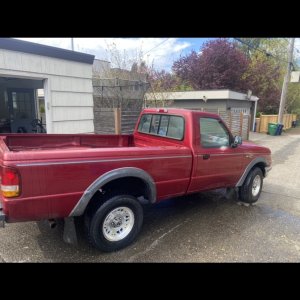danielwd
New Member
- Joined
- Dec 23, 2010
- Messages
- 56
- Reaction score
- 0
- Points
- 0
- Vehicle Year
- 1994
- Make / Model
- Ford
- Transmission
- Manual
Thanks to all for the many fixes that have been accomplished with your help over the last few months:
- New TPS sensor (solved code)
- Blocked EGR (solved code)
- New ECT (engine coolant temperature sensor) sensor (solved code)
- Replaced all four fuel injectors, cleaned TB and upper and lower intakes with new gaskets throughout (solved rough idle - inability to drive - one injector motor had completely failed)
- I removed A/C system because it hasn't worked in over a decade, and I needed room under the hood to work - specifically to install a brass flare nut on the EGR port off the headers. The evaporator was very much in my way, so I yanked it.
The truck is running great. I have even driven it across town multiple times.
However, I am observing a never-seen phenomenon with my newly repaired Ranger. I have owned this truck since 1994 and never observed it before.
On cold (or warm, or hot) startup, there is about a 1 second high idle and it completely bottoms out to probably around what I am estimating 500 to 600 RPMs.
The IAC valve is probably only a couple years old, if that. I have tested its resistance and it was 9.1 ohms. I backprobed the harness with truck running, and it was about 11.79 V.
I believe, if I remember right, that this may have begun after I changed out the ECT sensor. (I am wondering if it is defective, and I still have the old one - thinking about reinstalling old one to test idle upon startup)
There are no new codes either with key on or key off, it is passing all, except with key on/engine running and that is only because I have the DPFE sensor unplugged because the EGR system is blocked off.
Which brings me to another issue - with the EGR valve now blocked, I have two vacuum lines that used to be hooked to the EGR vacuum solenoid that are still pulling air from the lower intake canal (through the vacuum tree). Of course, the other line from the vacuum tree goes to the fuel pressure regulator. Should I block off these two lines (to and from EGR vacuum solenoid) with heavy duty tape or just let them leak and pull air in? I have tried both blocking off with tape and just allowing them to hang and pull air (I can hear the hiss with even the hood closed), and there has been no detected difference in performance. I can't believe that either scenario of blocking with tape or just letting them hang and hiss would not affect the performance of the truck, but to the best of my knowledge, at the present time, neither approach affects the truck either on startup or on the road.
I got excited thinking I may have figured out the lack of high idle on startup when I tightened the drive belt, and for a couple of seconds, there was indeed a normal high idle, and then...boom...dropped right back down as it has been doing. The excitement quickly diffused. Just how tight should the drive belt be - I am afraid to tighten it anymore - in fact, after tightening, it seems like it idled rough for a little while then mellowed out a bit?
So to recap - what could cause the lack of high idle on cold (or warm, or hot) startup? And what should I do about the two EGR vacuum solenoid hoses - should I tape them off or just allow them to hang and pull air?
Also...should I try and tighten drive belt even more than I already have - could a loose drive belt cause a lack of high idle upon startup?
Thanks so much in advance!!!!!
- New TPS sensor (solved code)
- Blocked EGR (solved code)
- New ECT (engine coolant temperature sensor) sensor (solved code)
- Replaced all four fuel injectors, cleaned TB and upper and lower intakes with new gaskets throughout (solved rough idle - inability to drive - one injector motor had completely failed)
- I removed A/C system because it hasn't worked in over a decade, and I needed room under the hood to work - specifically to install a brass flare nut on the EGR port off the headers. The evaporator was very much in my way, so I yanked it.
The truck is running great. I have even driven it across town multiple times.
However, I am observing a never-seen phenomenon with my newly repaired Ranger. I have owned this truck since 1994 and never observed it before.
On cold (or warm, or hot) startup, there is about a 1 second high idle and it completely bottoms out to probably around what I am estimating 500 to 600 RPMs.
The IAC valve is probably only a couple years old, if that. I have tested its resistance and it was 9.1 ohms. I backprobed the harness with truck running, and it was about 11.79 V.
I believe, if I remember right, that this may have begun after I changed out the ECT sensor. (I am wondering if it is defective, and I still have the old one - thinking about reinstalling old one to test idle upon startup)
There are no new codes either with key on or key off, it is passing all, except with key on/engine running and that is only because I have the DPFE sensor unplugged because the EGR system is blocked off.
Which brings me to another issue - with the EGR valve now blocked, I have two vacuum lines that used to be hooked to the EGR vacuum solenoid that are still pulling air from the lower intake canal (through the vacuum tree). Of course, the other line from the vacuum tree goes to the fuel pressure regulator. Should I block off these two lines (to and from EGR vacuum solenoid) with heavy duty tape or just let them leak and pull air in? I have tried both blocking off with tape and just allowing them to hang and pull air (I can hear the hiss with even the hood closed), and there has been no detected difference in performance. I can't believe that either scenario of blocking with tape or just letting them hang and hiss would not affect the performance of the truck, but to the best of my knowledge, at the present time, neither approach affects the truck either on startup or on the road.
I got excited thinking I may have figured out the lack of high idle on startup when I tightened the drive belt, and for a couple of seconds, there was indeed a normal high idle, and then...boom...dropped right back down as it has been doing. The excitement quickly diffused. Just how tight should the drive belt be - I am afraid to tighten it anymore - in fact, after tightening, it seems like it idled rough for a little while then mellowed out a bit?
So to recap - what could cause the lack of high idle on cold (or warm, or hot) startup? And what should I do about the two EGR vacuum solenoid hoses - should I tape them off or just allow them to hang and pull air?
Also...should I try and tighten drive belt even more than I already have - could a loose drive belt cause a lack of high idle upon startup?
Thanks so much in advance!!!!!
Last edited:














